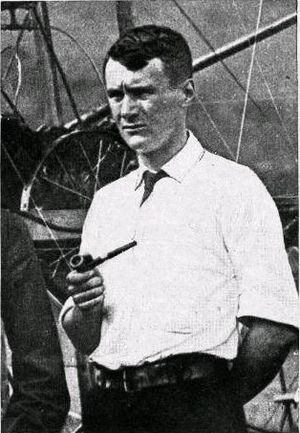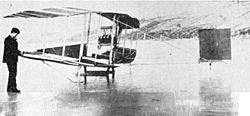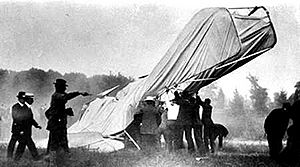Thomas Selfridge facts for kids
Quick facts for kids
Thomas Selfridge
|
|
|---|---|

Lieutenant Thomas Selfridge (1882–1908)
|
|
| Born | February 8, 1882 San Francisco, California |
| Died | September 17, 1908 (aged 26) Fort Myer, Virginia |
| Buried |
Arlington National Cemetery Section 3 Gravesite 2158
|
| Allegiance | |
| Service/ |
|
| Years of service | 1903–1908 |
| Rank | First Lieutenant |
| Unit | Aeronautical Division, U.S. Signal Corps |
| Relations | Thomas O. Selfridge, Sr. (grandfather), Thomas O. Selfridge, Jr. (uncle) |
Thomas Etholen Selfridge (born February 8, 1882 – died September 17, 1908) was a brave first lieutenant in the U.S. Army. He holds a sad record: he was the first person ever to die in an airplane crash. He was also the first active-duty U.S. military member to die while on duty in a plane accident. This happened when he was a passenger in a Wright Flyer, a famous early airplane, piloted by Orville Wright.
Contents
Early Life and Military Career
Thomas Selfridge was born in San Francisco, California, on February 8, 1882. His family had a history of military service. His uncle, Thomas Oliver Selfridge Jr., was a Rear Admiral in the Navy, and his grandfather, Thomas Oliver Selfridge Sr., was also a Rear Admiral.
Thomas graduated from the United States Military Academy in 1903. This is a famous school where people train to become officers in the Army. He joined the Artillery Corps, which uses large guns in battle. He was a good student, ranking 31st in his class.
In 1906, Thomas was stationed in the Presidio during a huge event: the 1906 San Francisco earthquake. His unit helped rescue people and clean up the city after this disaster.
A Pioneer in Aviation
In 1907, Selfridge joined the Aeronautical Division, U.S. Signal Corps at Fort Myer, Virginia. This was a new part of the military that focused on flying machines. He learned to fly a dirigible, which is like a large, steerable balloon.
He also became the U.S. government's representative to the Aerial Experiment Association (AEA). This group was led by Alexander Graham Bell, who invented the telephone. Selfridge became the first secretary of this important aviation group.
First Flights and Aircraft Designs
Thomas Selfridge took his first flight on December 6, 1907. He flew in Bell's "Cygnet" which was a special tetrahedral kite. It was made of 3,393 winged cells! He flew 168 feet high over Bras d'Or Lake in Nova Scotia, Canada, and stayed in the air for 7 minutes. This was the first time a passenger had flown in a heavier-than-air craft in Canada.
Selfridge also helped design the Red Wing, the AEA's first airplane with an engine. On March 12, 1908, the Red Wing was flown by Frederick W. Baldwin. It raced over the frozen Keuka Lake in New York on runners and flew 318 feet, 11 inches, before it crashed. The Red Wing was destroyed in another crash a few days later, but its engine was saved.
On May 19, 1908, Selfridge became the first U.S. military officer to fly a modern airplane by himself. He flew solo in AEA's new plane, White Wing. He flew 100 feet on his first try and 200 feet on his second. He made several more flights, reaching a height of 75 feet and flying for 1 minute and 30 seconds. Even though he wasn't a fully trained pilot, he was the first U.S. military officer to fly an airplane alone.
In August 1908, Selfridge was one of three pilots chosen to fly the Army Dirigible Number One. He was also very interested in the new airplanes being developed by the Wright brothers. He went to Fort Myer, Virginia, to see their demonstrations.
The Fatal Flight
In September 1908, Orville Wright came to Fort Myer to show off his 1908 Wright Military Flyer for the U.S. Army. On September 17, Selfridge arranged to be his passenger. The plane was carrying more weight than it ever had before, with both men on board.
The Flyer circled Fort Myer 4½ times at a height of 150 feet. Suddenly, halfway through the fifth circle, the right-hand propeller broke. This caused a lot of shaking, and the broken propeller hit a wire that supported the rudder (the part that steers the plane). The wire broke, and the rudder swung sideways, sending the Flyer into a nose dive.
Orville Wright quickly turned off the engine, but the plane hit the ground nose-first. Both men were thrown forward. Selfridge hit one of the wooden parts of the plane's frame, which fractured the base of his skull. He had surgery, but sadly, he died 3 hours later without waking up. Orville Wright was badly hurt too, with a broken leg and ribs, and was in the hospital for 7 weeks.
Orville Wright later described the accident in a letter to his brother, Wilbur Wright. He said that after the propeller broke, the machine started shaking terribly and then suddenly turned down and headed straight for the ground. Selfridge, who had been quiet, exclaimed "Oh! Oh!" in a very quiet voice as the plane fell.
Pictures taken before the flight show that Selfridge was not wearing any special headgear, while Wright only wore a cap. After the crash, people wondered if Selfridge would have lived if he had worn a helmet. Because of this, U.S. Army pilots were later told to wear large, heavy helmets, like early football helmets, to protect themselves.
Thomas Selfridge was buried in Arlington National Cemetery in Section 3 Gravesite 2158.
Legacy and Memorials
Selfridge Air National Guard Base in Harrison Township, Michigan, is named after him. This base is near Mt. Clemens, not far from Detroit, Michigan.
Even though he is buried in Arlington, there is a large memorial, called a cenotaph, for Selfridge in Section XXXIV of West Point Cemetery.
You can see the damaged propeller from the Wright Flyer that crashed at Fort Myer. It is on display at the National Museum of the United States Air Force, located at Wright-Patterson Air Force Base, in Dayton, Ohio.
A gate between Arlington National Cemetery and Joint Base Myer-Henderson Hall is also named Selfridge Gate in his honor.




